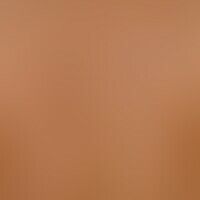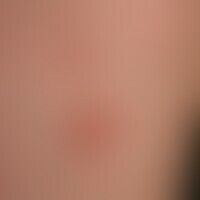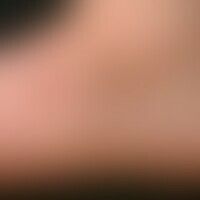Image diagnoses for "Leg/Foot"
395 results with 1158 images
Results forLeg/Foot

Tinea pedis (overview) B35.30
Tinea pedum: discrete, well defined, heart-shaped, slightly scaly erythema and hyperkeratosis on the right foot back of an 80-year-old female patient with exacerbated tinea pedum.

Skabies B86
Scabies (overview): itchy "rash" all over the body, existing for weeks; see previous figure. findings: disseminated, red scaly papules, partly also linearly arranged. itching at night intensified in bed warmth

Erysipelas A46
Erysipelas, acute: a sharply defined, flat, rich reddening of the lower leg under high fever with the formation of blisters and blisters, accompanied by painful regional lymphadenitis.

Circumscribed scleroderma L94.0
Circumscripts of scleroderma (small-heart plaque or confetti type): disseminated, symptomless, 0.1-0.2 cm large, confetti-like, white spots/papules with (incident light microscopic) detectable, atropically shiny surface. The skin lesions have now been discovered (by chance) after sunbathing. Histology: No evidence of Lichen sclerosus.

Erysipelas A46
Erysipelas, acute acute reddening of the back of the foot under high fever, sharply limited and extensive hemorrhagic blistering.

Necrobiosis lipoidica L92.1
Necrobiosis lipoidica: Overview of the left thigh: Approx. 3 cm large, slightly elevated, erythematous plaque without ulcerations.

Hypertrophic Lichen planus L43.81
Lichen planus verrucosus. solitary, chronically stationary, for months unchanged, very itchy, 5.0 cm large, rough, red, verrucous plaques on the lower leg. a highly chronic course over years is to be expected.

Tinea pedis (overview) B35.30
Tinea pedum (moccasin type). general view: For about 13 years non-healing redness and scaling, partly with severe itching, in the area of the right foot in a 30-year-old female patient. sharply defined, marginal scaling erythema, pustular formation, swelling of the foot with limited walking ability.

Asteatotic dermatitis L30.8
Desiccation dermatitis: slight, pityriasiform scaling with a characteristic craquelée pattern with linear cracking

Erysipelas bullous
Erysipelas bullöses: acuteextensive, sharply defined, painful reddening and plaque with circumscribed large blisters; entry portal: tinea pedum.

Lichen sclerosus extragenital L90.0
Lichen sclerosus extragenitaler: white plaque with a shiny surface, existing for several months, completely without symptoms, slowly progressive; differential diagnosis is to exclude a morphea (histological confirmation).

Tinea cruris B35.8
Tinea cruris: chronic plaque that is slightly faded in the centre, accentuated at the edges, covering a large area and moderately itchy.

Tinea pedis (overview) B35.30
Tinea pedum, detail enlargement: Sharply defined, marginal scaly erythema, pustular formation, scaly seam along the edge of the foot and multiple scratch excoriations, some of which are crusty.

Drug reaction lymphocytic T88.7
drug reaction, lymphocytes: multiple, non-symptomatic, surface-smooth papules and plaques. occurred several months after cardiological readjustment. patient otherwise healthy. no evidence of lymphatic systemic disease. no other drugs. histological: nodular, mature lymphocytic tissue. no lymph follicles.

Erythema infectiosum B08.30
Erythema infectiosum: partly anular partly reticular erythema on the lower extremity.









